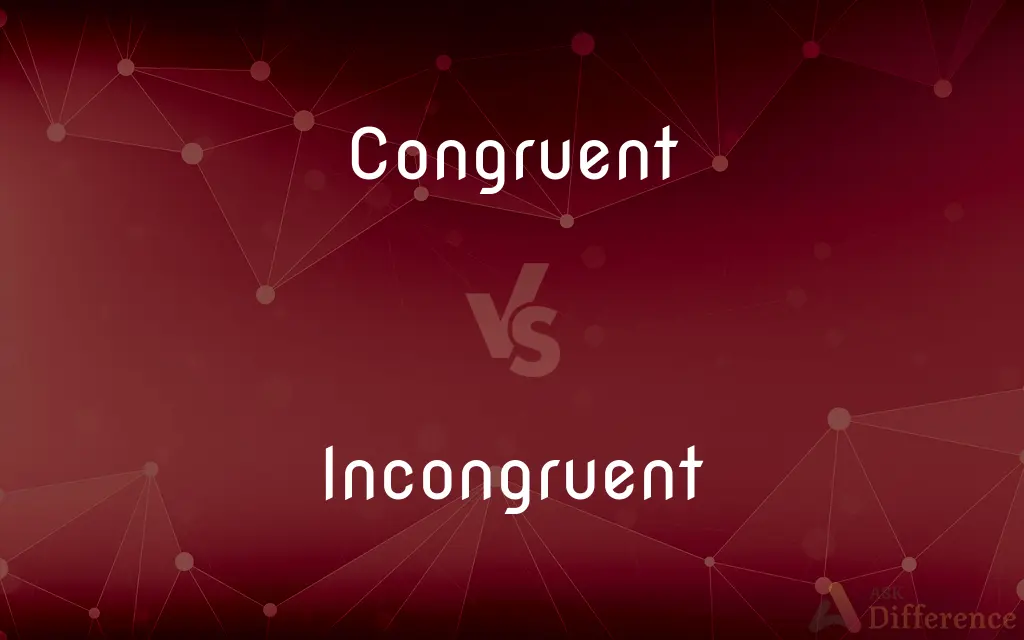Congruent vs. Incongruent — What's the Difference?
Edited by Tayyaba Rehman — By Fiza Rafique — Updated on March 25, 2024
Congruent implies harmony and agreement in terms of shape, size, or idea, while incongruent suggests a lack of alignment or compatibility.

Difference Between Congruent and Incongruent
Table of Contents
ADVERTISEMENT
Key Differences
Congruent objects or ideas are those that align perfectly in shape, size, or agreement, demonstrating a harmonious correspondence. For instance, in geometry, two shapes are congruent if they have the same size and shape, highlighting a perfect match or agreement. On the other hand, incongruent refers to elements that do not align or match, indicating a discrepancy or inconsistency in their relationship. This can pertain to shapes that do not fit together perfectly or ideas that are not in harmony.
In mathematics, congruency is a fundamental concept used to describe figures that can be superimposed on each other, indicating they are identical in form and dimensions. This principle is critical for solving problems related to geometry and proving theorems. Conversely, incongruency in mathematics signifies figures or equations that cannot be made identical through rotation, reflection, or translation, emphasizing a fundamental difference in their properties or structures.
In psychology, congruence and incongruence are terms used to describe the alignment or misalignment between an individual's self-image and their actual experiences. Congruence reflects a state where a person's self-perception closely matches their experiences, leading to a sense of harmony and well-being. In contrast, incongruence represents a discrepancy between these elements, often resulting in feelings of discomfort, confusion, or distress, as the individual struggles to reconcile their self-image with reality.
In communication, congruence refers to the alignment between verbal messages and non-verbal cues, enhancing the clarity and effectiveness of the communication. When someone's words match their body language, the message is considered congruent, fostering trust and understanding. However, when there is a discrepancy between what is said and the non-verbal signals sent, the communication is incongruent, potentially leading to misunderstandings and mistrust as the receiver senses a lack of authenticity or alignment.
Congruent and incongruent conditions also apply to experimental designs in psychological research, where congruent tasks involve stimuli that are harmoniously aligned, facilitating easier and quicker responses. In contrast, incongruent tasks present stimuli that conflict, requiring more cognitive effort to resolve the discrepancy, often used to study attention, perception, and cognitive processing.
ADVERTISEMENT
Comparison Chart
Definition
Aligning perfectly in shape, size, or idea
Lacking alignment or compatibility
In Mathematics
Figures are identical in form and dimensions
Figures cannot be made identical
In Psychology
Alignment between self-image and experiences
Discrepancy between self-image and experiences
In Communication
Verbal and non-verbal messages align
Verbal and non-verbal messages do not align
Experimental Design
Tasks involve harmoniously aligned stimuli
Tasks present stimuli that conflict
Compare with Definitions
Congruent
Expressions or equations that are identical in value.
The equations are congruent, yielding the same result when solved.
Incongruent
Tasks that require resolving conflicting stimuli.
Incongruent conditions in experiments often slow down response times.
Congruent
In tasks where stimuli are aligned, facilitating quick responses.
Congruent tasks in the Stroop test are completed more swiftly.
Incongruent
A discrepancy between what is said and the non-verbal signals.
His incongruent body language caused confusion among the listeners.
Congruent
When verbal and non-verbal cues align.
His congruent gestures reinforced his message of reassurance.
Incongruent
Figures that do not match in shape and size.
Despite their similar appearances, the two polygons are incongruent.
Congruent
Figures that perfectly match in shape and size.
The two triangles are congruent, having identical angles and side lengths.
Incongruent
A misalignment between self-image and reality.
Feeling incongruent can lead to stress and anxiety.
Congruent
A state of agreement between one's self-perception and experiences.
Achieving congruence in therapy leads to improved mental well-being.
Incongruent
Equations or expressions that do not equate.
These equations are incongruent, leading to different solutions.
Congruent
Corresponding; congruous.
Incongruent
Not congruent.
Congruent
Coinciding exactly when superimposed
Congruent triangles.
Incongruent
Incongruous.
Congruent
Of or relating to two numbers that have the same remainder when divided by a third number. For example, 11 and 26 are congruent when the modulus is 5.
Incongruent
Out of place, incompatible, inharmonious, not congruent
The yellow blazer was incongruent for the funeral.
Her knowledge of world politics was incongruent in someone so young.
Congruent
Corresponding in character; congruous
Incongruent
(mathematics) of or relating to two numbers that have different remainders when divided by a third number
Congruent
Harmonious.
Incongruent
Incongruous.
Congruent
(mathematics) Having a difference divisible by a modulus.
Incongruent
Not congruent
Congruent
(mathematics) Coinciding exactly when superimposed.
Congruent
(algebra) Satisfying a congruence relation.
Congruent
Possessing congruity; suitable; agreeing; corresponding.
The congruent and harmonious fitting of parts in a sentence.
Congruent
Corresponding in character or kind
Congruent
Coinciding when superimposed
Common Curiosities
How do incongruent figures differ in mathematics?
Incongruent figures in mathematics are those that cannot be made identical through rotation, reflection, or translation, showing fundamental differences.
What does congruent mean?
Congruent refers to agreement or harmony in shape, size, or idea, indicating a perfect match or alignment.
How does incongruence affect communication?
Incongruence in communication, marked by discrepancies between verbal and non-verbal cues, can lead to misunderstandings and mistrust.
What are congruent and incongruent tasks in psychological research?
Congruent tasks involve stimuli that are harmoniously aligned, whereas incongruent tasks present conflicting stimuli, affecting cognitive processing.
What is psychological congruence?
Psychological congruence is the alignment between an individual's self-perception and their actual experiences, leading to a sense of harmony and well-being.
What leads to psychological incongruence?
Psychological incongruence arises from a discrepancy between one's self-image and their experiences, causing discomfort or distress.
What role does congruence play in effective leadership?
Congruence in leadership involves aligning words with actions, crucial for credibility and inspiring trust among followers.
Can congruence be applied to relationships?
Yes, congruence in relationships refers to consistency and harmony in actions, words, and beliefs, fostering trust and understanding.
Why is congruence important in therapy?
Congruence is important in therapy as it fosters an authentic and harmonious relationship between the therapist and client, facilitating healing.
What is the significance of congruent angles in geometry?
Congruent angles in geometry are significant as they indicate angles of identical measure, essential for solving geometric problems.
How is congruency used in geometry?
In geometry, congruency is used to describe shapes that are identical in form and dimensions, allowing them to be perfectly superimposed.
How do incongruent tasks affect cognitive performance?
Incongruent tasks can slow down cognitive performance as they require additional effort to resolve the conflict between conflicting stimuli.
Can mathematical expressions be congruent?
Yes, mathematical expressions that are identical in value or form are considered congruent, showing equivalence.
How does incongruence manifest in body language?
Incongruence in body language appears as a mismatch between verbal communication and non-verbal cues, leading to ambiguity.
Share Your Discovery

Previous Comparison
Paralysis vs. Palsy
Next Comparison
Jibe vs. JiveAuthor Spotlight
Written by
Fiza RafiqueFiza Rafique is a skilled content writer at AskDifference.com, where she meticulously refines and enhances written pieces. Drawing from her vast editorial expertise, Fiza ensures clarity, accuracy, and precision in every article. Passionate about language, she continually seeks to elevate the quality of content for readers worldwide.
Edited by
Tayyaba RehmanTayyaba Rehman is a distinguished writer, currently serving as a primary contributor to askdifference.com. As a researcher in semantics and etymology, Tayyaba's passion for the complexity of languages and their distinctions has found a perfect home on the platform. Tayyaba delves into the intricacies of language, distinguishing between commonly confused words and phrases, thereby providing clarity for readers worldwide.
















































